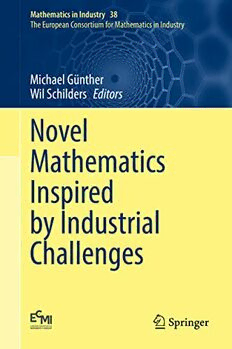
Novel Mathematics Inspired by Industrial Challenges (Mathematics in Industry, 38) PDF
Preview Novel Mathematics Inspired by Industrial Challenges (Mathematics in Industry, 38)
Mathematics in Industry 38 The European Consortium for Mathematics in Industry Michael Günther Wil Schilders Editors Novel Mathematics Inspired by Industrial Challenges Mathematics in Industry The European Consortium for Mathematics in Industry Volume 38 ManagingEditor MichaelGünther,UniversityofWuppertal,Wuppertal,Germany SeriesEditors LuisL.Bonilla,UniversityCarlosIIIMadrid,Escuela,Leganes,Spain OtmarScherzer,UniversityofVienna,Vienna,Austria WilSchilders,EindhovenUniversityofTechnology,Eindhoven,TheNetherlands The ECMI subseries of the Mathematics in Industry series is a project of The European Consortium for Mathematics in Industry. Mathematics in Industry focusesontheresearchandeducationalaspectsofmathematicsusedinindustryand otherbusinessenterprises.BooksforMathematicsinIndustryareinthefollowing categories: research monographs, problem-oriented multi-author collections, textbookswithaproblem-orientedapproach,conferenceproceedings.Relevanceto the actualpracticaluse of mathematicsin industry is the distinguishingfeatureof thebooksintheMathematicsinIndustryseries. Moreinformationaboutthissubseriesathttps://link.springer.com/bookseries/4651 Michael Günther • Wil Schilders Editors Novel Mathematics Inspired by Industrial Challenges Editors Michael Günther Wil Schilders Applied Math. & Numerical Analysis Mathematics Bergische Universität Wuppertal TU Eindhoven Wuppertal, Nordrhein-Westfalen Eindhoven, Noord-Brabant Germany The Netherlands ISSN 1612-3956 ISSN 2198-3283 (electronic) Mathematics in Industry The European Consortium for Mathematics in Industry ISBN 978-3-030-96172-5 ISBN 978-3-030-96173-2 (eBook) https://doi.org/10.1007/978-3-030-96173-2 Mathematics Subject Classification (2020): 00A69, 68U99, 68T09 © The Editor(s) (if applicable) and The Author(s), under exclusive license to Springer Nature Switzerland AG2022 This work is subject to copyright. All rights are solely and exclusively licensed by the Publisher, whether the whole or part of the material is concerned, specifically the rights of translation, reprinting, reuse of illustrations, recitation, broadcasting, reproduction on microfilms or in any other physical way, and transmission or information storage and retrieval, electronic adaptation, computer software, or by similar or dissimilar methodology now known or hereafter developed. The use of general descriptive names, registered names, trademarks, service marks, etc. in this publication does not imply, even in the absence of a specific statement, that such names are exempt from the relevant protective laws and regulations and therefore free for general use. The publisher, the authors and the editors are safe to assume that the advice and information in this book are believed to be true and accurate at the date of publication. Neither the publisher nor the authors or the editors give a warranty, expressed or implied, with respect to the material contained herein or for any errors or omissions that may have been made. The publisher remains neutral with regard to jurisdictional claims in published maps and institutional affiliations. This Springer imprint is published by the registered company Springer Nature Switzerland AG The registered company address is: Gewerbestrasse 11, 6330 Cham, Switzerland Toourlovedones Preface Mathematicsisessentialforinnovationsinindustryandscience.Inmanycountries, bookswithsuccessstoriesofmathematicshavebeenpublished 1,reportsbyinde- pendent accountants have shown the high economic value of mathematics234, and theStudyGroupsofMathematicswithIndustryarespreadallovertheworld5.Con- ferenceslikethebiennialECMIconference,thebiennialSIAMCSEconferenceand theICIAMconferenceorganizedevery4yearscontainalargevarietyofapplications ofmathematicstochallengesfromindustryandothersciences. Despiteallofthesesuccessstories,itisstillclaimedthatthesesuccessesbuildon existingmathematics,thatnonewmathematicsisgeneratedandthatmathematicsfor industryisnotchallengingatall.Someevenfeelthatnewmathematicsisonlycreated by brilliant theoretical mathematicians. A prominent and well-known example is formedbythenumber-theoreticresultsobtainedbythefamousmathematicianHardy inthe1940s,thatarenowthebasisofallencryptionalgorithmsusedforfinancial transactions.Hardyhimselfwouldneverhavedreamedaboutthis,infacthewould haveconsidereditanightmarethathismethodsareusedforsomethingpractical. Withthisbook,wewishtodemonstratethatmathematicsforindustryischalleng- ingandextremelyrewarding,leadingtonewmathematicalmethodsandsometimes even to entirely new fields within mathematics. A nice example from our own ex- perienceisthesolutionofindefinitelinearsystemswhichoriginatedfromworking on electronic circuit simulation. Solving the large linear systems associated with electronic circuits often led to problems with pivoting. Then the idea came up to usethefactthattherearetwovariablesintheproblem:currentsandvoltages.This inspiredustore-orderthematrixintermsof2x2blocks,couplingvoltagestocur- 1 https://www.eu-maths-in.eu/wp-content/uploads/2017/01/2011_FLMI-EU_IndustrialMaths- SuccessStories.pdf 2 https://www.platformwiskunde.nl/wp-content/uploads/2016/10/Deloitte-rapport-20140115-Ma- thematical-sciences.pdf 3 https://www.eu-maths-in.eu/wp-content/uploads/2016/02/2015-France-SocioEconomic_Im- pact_of_Mathematics.pdf 4http://www.eu-maths-in.eu/wp-content/uploads/2019/04/MathematicsImpactStudy_Spain.pdf 5https://ecmiindmath.org/study-groups/ vii viii Preface rents.Thesuccesswasimmediate,nopivotingwasrequiredanymore.Themethod was generalised, so that it is applicable to all kinds of indefinite systems, and not onlythosecomingfromelectroniccircuits.Itledtoverynicenewresearchresults, andnewmethodsforindefinitelinearsystems 67.Anotherexampleisthedevelop- mentofmethodswithinthefieldofmodelorderreduction.Thisfieldhasbenefited muchfromdemandsofanddevelopmentsintheelectronicsindustry.Methodslike PRIMA 8 and SPRIM 9 originated here, as did many other developments, but all methodsaregenerallyapplicable.Inrecentyearsweobserveamuchwidervariety ofapplicationsofmodelorderreduction. Thisbookpresentsmethodsthatfallintothecategorysketchedintheforegoing paragraph.Thestartingpointisalwaysanindustrialchallenge.Thechaptersdescribe how the authors addressed the challenge and developed new methods that were initiallyspecificfortheapplication,butlaterformulatedforgeneralapplication.The bookissplitintotwoparts,oneonengineeringapplicationsandoneonstochastics andfinance. Allchapterscontainedinthisbookclearlyshowthatindustrialchallengesdolead tothedevelopmentofnewmathematicalmethods,orevencompletelynewfieldsof mathematics,neededtoaddressthesechallenges.Thestartingpointmaybeanappli- cationofexistingmathematicalmethods,butwhenitisfoundthatmoreisneeded,or differentmethods,thentheinteractionbetweenapplicationandmathematicsstarts. Mathematicianscanthenontheonehanddevelopnewmathematicaltechniques,on the other hand solve the challenges. This is extremely rewarding, it often leads to nice journal papers on the theoretical results, which subsequently are the starting pointofalotoffurtherresearchinsidethemathematicsarea.Italsoleadstopapers inappliedjournals. Concluding,wemaysaythat“mathematicsforindustry”or,evenbroader,“applied mathematics”, is much more than just applying existing mathematical methods to industrialproblems.Inmanycases,theapplicationofexistingmethodsdoesnotlead tothedesiredsolution,andhenceadaptationsofexistingmethodsorevenentirely new methods need to be developed in order to effectively address the industrial challenge.Insomecases,thishasledtoentirelynewfieldswithinmathematics.The interplaybetweenmathematicsandindustryis,hence,beneficialforboth.Industry benefits by having their problems solved and mathematics benefits because new methodsaredevelopedthatareversatileinnature. 6H.S.Dollar,N.I.M.Gould,W.H.A.Schilders,A.J.Wathen:Oniterativemethodsandimplicit- factorizationpreconditionersforregularizedsaddle-pointsystems,SIAMJ.Matr.Anal.Appl.(27) 170–189(2006) 7W.H.A.Schilders:SolutionofindefinitelinearsystemsusinganLQdecompositionforthelinear constraints,LinearAlgebraanditsApplications431:30-4381–395(2009) 8A.Odabasioglu,M.CelikandL.T.Pileggi:PRIMA:passivereduced-orderinterconnectmacro- modelingalgorithm,IEEETrans.Comp.Aid.Dsg.Int.Circ.Syst.17:8645–654(1998) 9R.W.Freund:Structure-PreservingModelOrderReductionofRCLCircuitEquations,in:W.H.A. Schilders,H.A.vanderVorstandJ.Rommes(eds):ModelOrderReduction:Theory,Research AspectsandApplications,SpringerVerlag,Heidelberg,51–75(2008) Preface ix ThebookcontainstwopartsonapplicationsinComputationalScienceandEngi- neeringandDataAnalysisandFinance.Itshouldberemarkedthatallauthorshave beenaskedtostartandendtheirchapterwithabriefdescriptionofwhytheirchapter fitsintothisvolume:explainingwhichindustrialchallengeshavebeeninstrumental fortheirinspiration,andwhichmethodshavebeendevelopedasaresult. WuppertalandEindhoven, MichaelGünther Spring2021 WilSchilders Acknowledgements WearegratefultoDr.JörgMittelstenScheidforhisgenerousgranttotheBergische Universität Wuppertal, which had made possible the Mittelsten Scheid Visiting ProfessorshipofProf.dr.W.H.A.Schildersinthewintersemester2020/2021atthe Faculty of Mathematics and Natural Sciences. In the course of this semester, the workonthisbookcouldbeadvancedadecisivepiece,whichwouldnothavebeen possiblesoeasilywithoutProf.Schilders’stayinWuppertal. WearegratefultoDr.HarshitBansalforhisvaluablehelpinanumberofLaTex andlayoutproblems. xi
